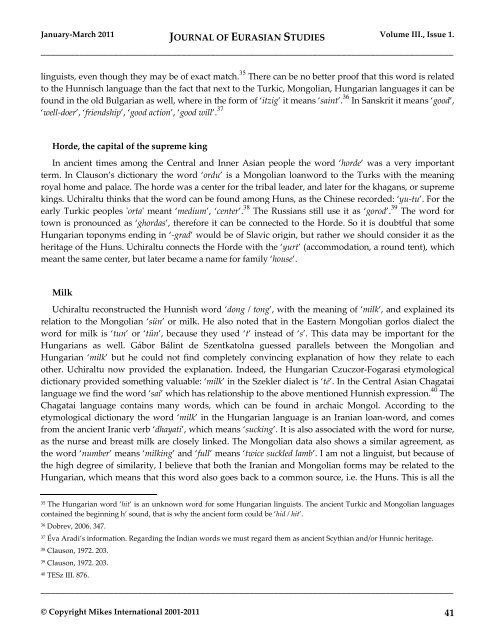JOURNAL OF EURASIAN STUDIES
JOURNAL OF EURASIAN STUDIES
JOURNAL OF EURASIAN STUDIES
You also want an ePaper? Increase the reach of your titles
YUMPU automatically turns print PDFs into web optimized ePapers that Google loves.
January-March 2011 <strong>JOURNAL</strong> <strong>OF</strong> <strong>EURASIAN</strong> <strong>STUDIES</strong> Volume III., Issue 1.<br />
_____________________________________________________________________________________<br />
linguists, even though they may be of exact match. 35 There can be no better proof that this word is related<br />
to the Hunnisch language than the fact that next to the Turkic, Mongolian, Hungarian languages it can be<br />
found in the old Bulgarian as well, where in the form of ‘itzig’ it means ‘saint’. 36 In Sanskrit it means ‘good’,<br />
‘well-doer’, ‘friendship’, ‘good action’, ‘good will’. 37<br />
Horde, the capital of the supreme king<br />
In ancient times among the Central and Inner Asian people the word ‘horde’ was a very important<br />
term. In Clauson’s dictionary the word ‘ordu’ is a Mongolian loanword to the Turks with the meaning<br />
royal home and palace. The horde was a center for the tribal leader, and later for the khagans, or supreme<br />
kings. Uchiraltu thinks that the word can be found among Huns, as the Chinese recorded: ‘yu-tu’. For the<br />
early Turkic peoples 'orta' meant ‘medium’, ‘center’. 38 The Russians still use it as ‘gorod’. 39 The word for<br />
town is pronounced as ‘ghordas’, therefore it can be connected to the Horde. So it is doubtful that some<br />
Hungarian toponyms ending in ‘-grad’ would be of Slavic origin, but rather we should consider it as the<br />
heritage of the Huns. Uchiraltu connects the Horde with the ‘yurt’ (accommodation, a round tent), which<br />
meant the same center, but later became a name for family ‘house’.<br />
Milk<br />
Uchiraltu reconstructed the Hunnish word ‘dong / tong’, with the meaning of ‘milk’, and explained its<br />
relation to the Mongolian ‘sün’ or milk. He also noted that in the Eastern Mongolian gorlos dialect the<br />
word for milk is ‘tun’ or ‘tün’, because they used ‘t’ instead of ‘s’. This data may be important for the<br />
Hungarians as well. Gábor Bálint de Szentkatolna guessed parallels between the Mongolian and<br />
Hungarian ‘milk’ but he could not find completely convincing explanation of how they relate to each<br />
other. Uchiraltu now provided the explanation. Indeed, the Hungarian Czuczor-Fogarasi etymological<br />
dictionary provided something valuable: ‘milk’ in the Szekler dialect is ‘té’. In the Central Asian Chagatai<br />
language we find the word ‘sai’ which has relationship to the above mentioned Hunnish expression. 40 The<br />
Chagatai language contains many words, which can be found in archaic Mongol. According to the<br />
etymological dictionary the word ‘milk’ in the Hungarian language is an Iranian loan-word, and comes<br />
from the ancient Iranic verb ‘dhayati’, which means ‘sucking’. It is also associated with the word for nurse,<br />
as the nurse and breast milk are closely linked. The Mongolian data also shows a similar agreement, as<br />
the word ‘number’ means ‘milking’ and ‘full’ means ‘twice suckled lamb’. I am not a linguist, but because of<br />
the high degree of similarity, I believe that both the Iranian and Mongolian forms may be related to the<br />
Hungarian, which means that this word also goes back to a common source, i.e. the Huns. This is all the<br />
35 The Hungarian word ’hit’ is an unknown word for some Hungarian linguists. The ancient Turkic and Mongolian languages<br />
contained the beginning h’ sound, that is why the ancient form could be ’hid / hit’.<br />
36 Dobrev, 2006. 347.<br />
37 Éva Aradi’s information. Regarding the Indian words we must regard them as ancient Scythian and/or Hunnic heritage.<br />
38 Clauson, 1972. 203.<br />
39 Clauson, 1972. 203.<br />
40 TESz III. 876.<br />
_____________________________________________________________________________________<br />
© Copyright Mikes International 2001-2011 41

















